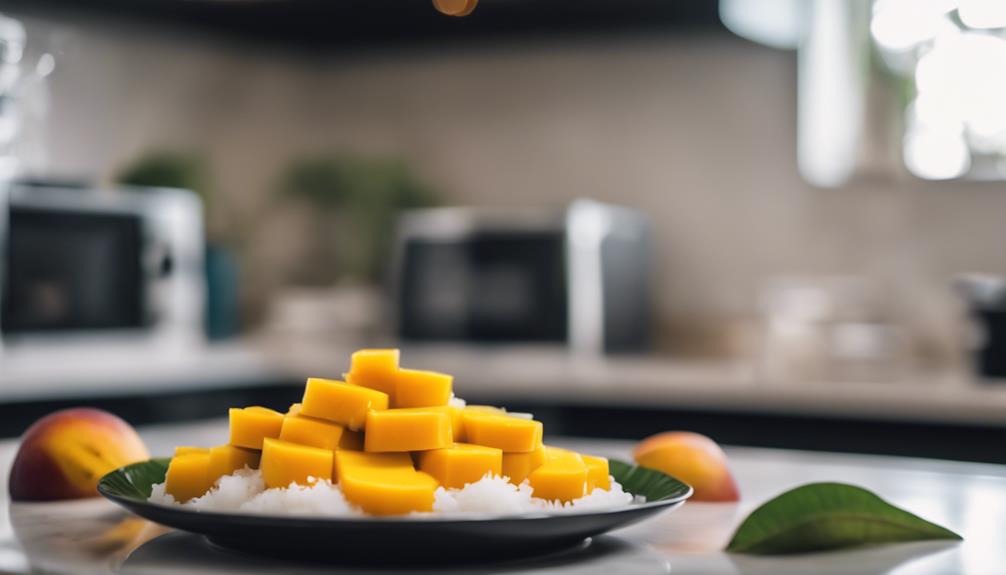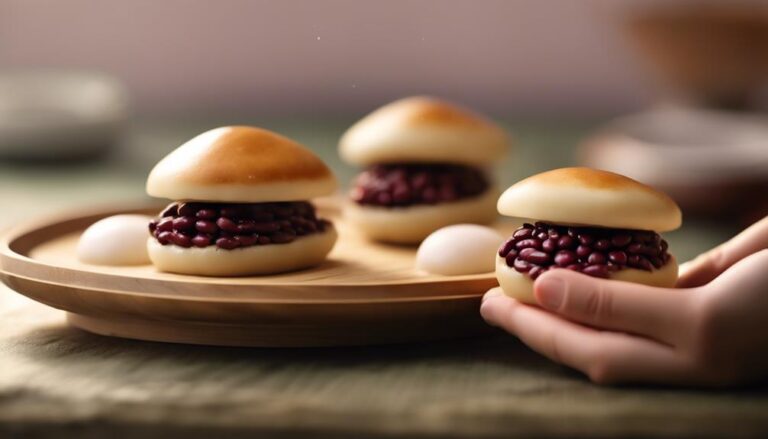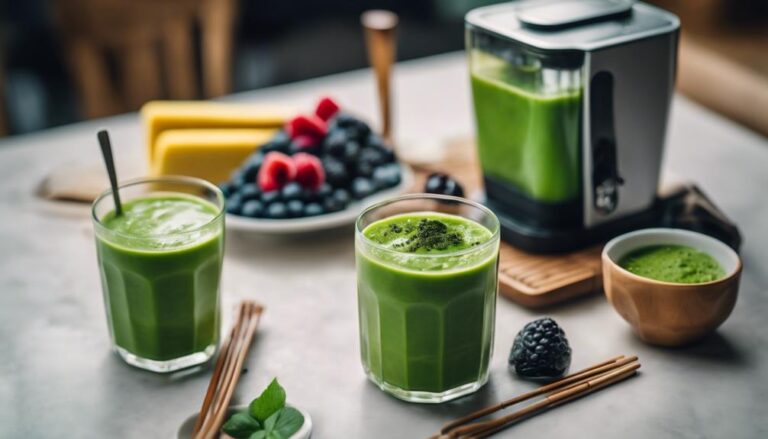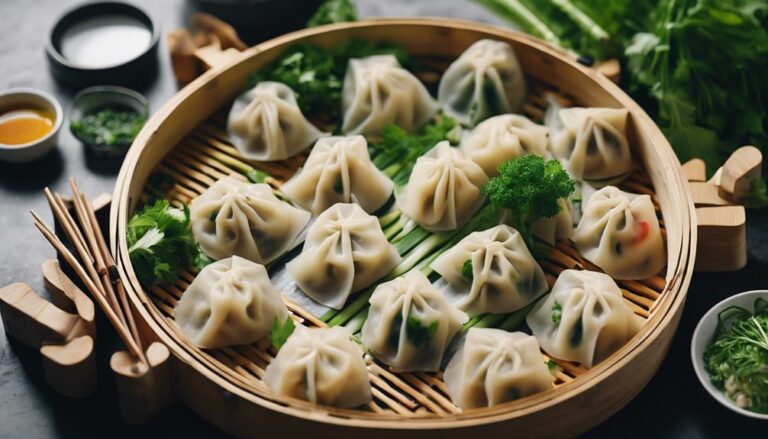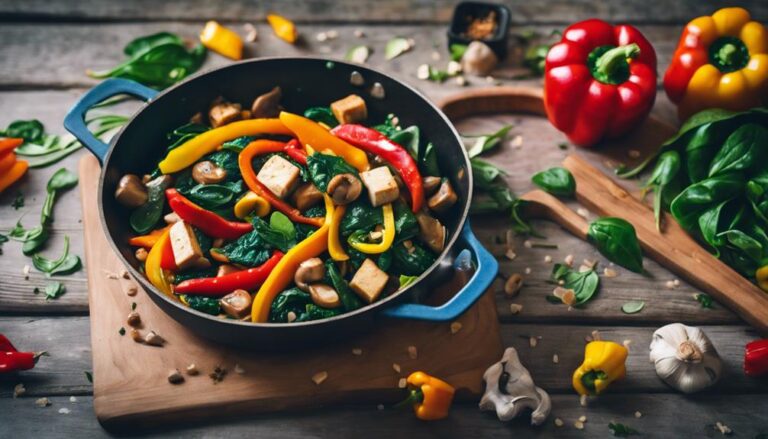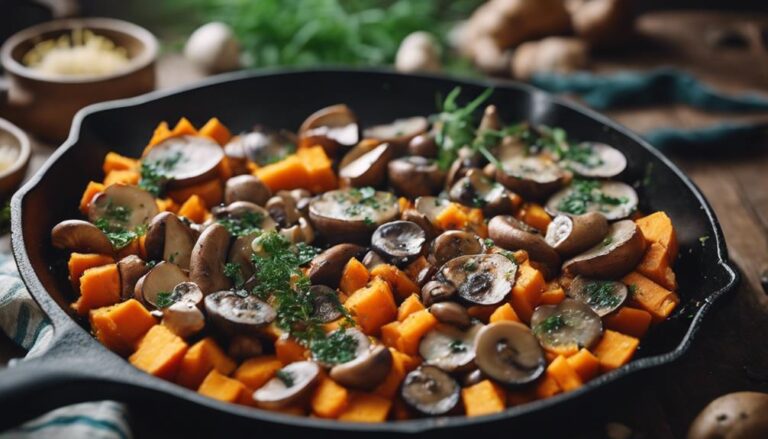Sous Vide Mango Sticky Rice: A Classic Asian Heritage Dessert
Explore the flavors of Thai cuisine with sous vide mango sticky rice, a classic dessert blending tradition and innovation. The dish signifies unity and celebration in Asian culture. Tantalize your taste buds with the perfect balance of sweet, sour, and creamy textures, achieved through precise cooking techniques. Indulge in the creamy goodness of coconut milk and sticky rice, highlighting the rich culinary heritage of Thailand. Elevate your culinary experience with this beloved dessert, where modern twists and flavor variations add an exciting dimension to a cultural masterpiece. Find out more about this delectable treat and its evolution in the culinary world.
What You Will Learn Here
- Sous vide technique ensures precise cooking temperatures for perfect mango sticky rice.
- Balances traditional flavors with innovative cooking methods.
- Infuse coconut milk and sticky rice for creamy texture and authentic taste.
- Explore flavor variations with mango extracts and unconventional garnishes.
- Honoring Thai culinary heritage through a modern twist on a classic dessert.
Origins in Thai Cuisine
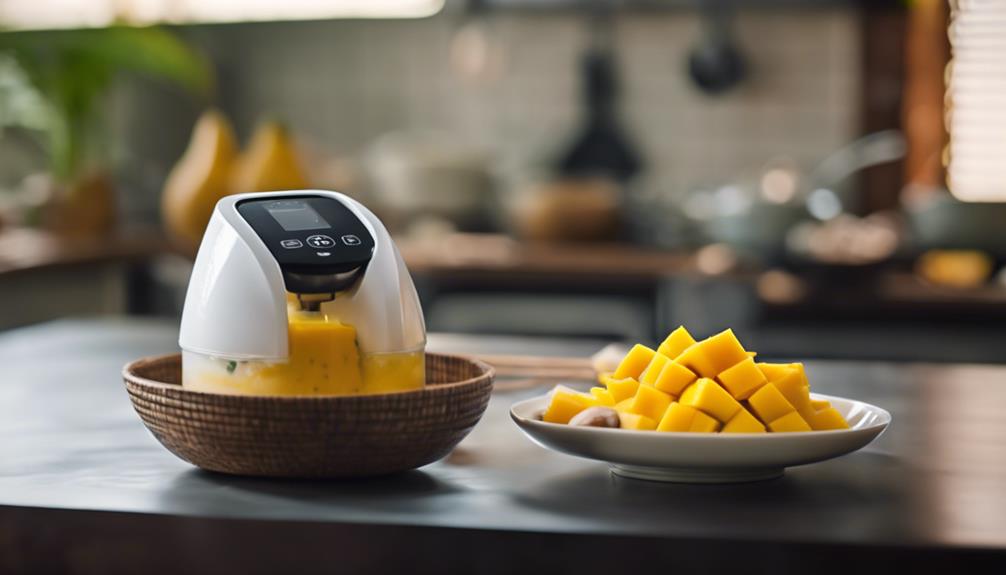
Thai cuisine boasts a rich tapestry of flavors and ingredients that reflect the country's diverse culinary roots. Traditional techniques, such as steaming glutinous rice and infusing it with creamy coconut milk, are at the heart of creating iconic dishes like mango sticky rice.
This dessert holds cultural significance in Asia, often served during special occasions and celebrations.
Thai Culinary Roots
With a rich history deeply intertwined with cultural traditions, the origins of Thai cuisine can be traced back to ancient times. Thai flavors have a sweet history, reflecting the diverse culinary traditions and dessert evolution of the region.
Thai cuisine is renowned for its harmonious balance of flavors, often combining sweet, sour, salty, and spicy elements in dishes that delight the senses.
The use of fresh herbs and spices, such as lemongrass, galangal, and kaffir lime leaves, contributes to the unique and vibrant taste of Thai dishes. These ingredients, along with coconut milk, palm sugar, and tropical fruits like mangoes, play a significant role in creating the distinct sweet and savory profiles that define Thai cuisine.
Over the centuries, Thai culinary traditions have evolved, influenced by neighboring countries and global trade. This rich tapestry of influences has shaped the way Thai desserts are prepared and enjoyed today, making them a beloved part of the country's cultural heritage.
Traditional Preparation Techniques
Explore the traditional preparation techniques rooted in Thai cuisine, showcasing the intricate methods that have been honed over generations to craft flavorful and aromatic dishes.
In Thai culinary traditions, mango sticky rice is often prepared through a process that involves steaming the rice with coconut milk and sugar, creating a rich and sweet base for the dish. The mango is then sliced and arranged on top, providing a vibrant contrast to the creamy rice.
Sous vide cooking offers modern advantages while staying true to these traditional methods. By using sous vide, the flavors of the coconut milk and sugar are preserved at precise temperatures, ensuring a consistent and delicious outcome every time.
This method also allows for the rice to achieve the perfect texture, soft yet slightly chewy, enhancing the overall experience of the dish. Through sous vide cooking, the essence of this beloved dessert is encapsulated, paying homage to its cultural roots while embracing innovative techniques for flavor preservation.
Cultural Significance in Asia
Rooted in Thai culinary traditions, mango sticky rice holds a significant place in Asian cuisine, reflecting the cultural heritage and flavors that define this beloved dessert.
In Asia, mango sticky rice isn't just a sweet indulgence but a dish rich in cultural symbolism, often enjoyed during festive celebrations and family gatherings. The combination of fragrant sticky rice, ripe mango slices, and sweet coconut milk creates a harmonious blend of flavors that symbolize unity and prosperity in Thai culture.
During festive celebrations in Thailand, such as Songkran (Thai New Year) or Loy Krathong (Festival of Lights), mango sticky rice is a popular treat shared among loved ones to mark joyous occasions and strengthen bonds within the community. This dessert's vibrant colors and aromatic taste embody the essence of togetherness and abundance, making it a staple in Thai households during special gatherings.
Whether served as a dessert at a family feast or as a symbolic dish at cultural events, mango sticky rice continues to be cherished for its ability to bring people together in celebration and appreciation of Thai culinary heritage.
Sticky Rice and Coconut Milk
You'll find that the combination of sticky rice and coconut milk creates a rich and creamy base for the Sous Vide Mango Sticky Rice dish.
When preparing this delightful dessert, consider the following:
- Coconut Milk Benefits: Coconut milk isn't only delicious but also offers a range of health benefits. It contains essential nutrients like vitamins C, E, B1, B3, B5, and B6, as well as minerals such as iron, selenium, sodium, calcium, magnesium, and phosphorus.
- Sticky Rice Variations: Sticky rice comes in different varieties, including glutinous and non-glutinous options. Each type offers a unique texture and taste, allowing you to experiment with different versions of this traditional ingredient.
- Creamy Texture: The combination of sticky rice and coconut milk results in a velvety and luscious texture that perfectly complements the sweetness of the mangoes.
- Balanced Flavor: The subtle nuttiness of the sticky rice pairs harmoniously with the tropical notes of the coconut milk, creating a well-rounded flavor profile.
- Cultural Significance: Sticky rice and coconut milk are staples in many Asian desserts, reflecting the rich culinary heritage of the region.
Top-rated Mango Sticky Rice
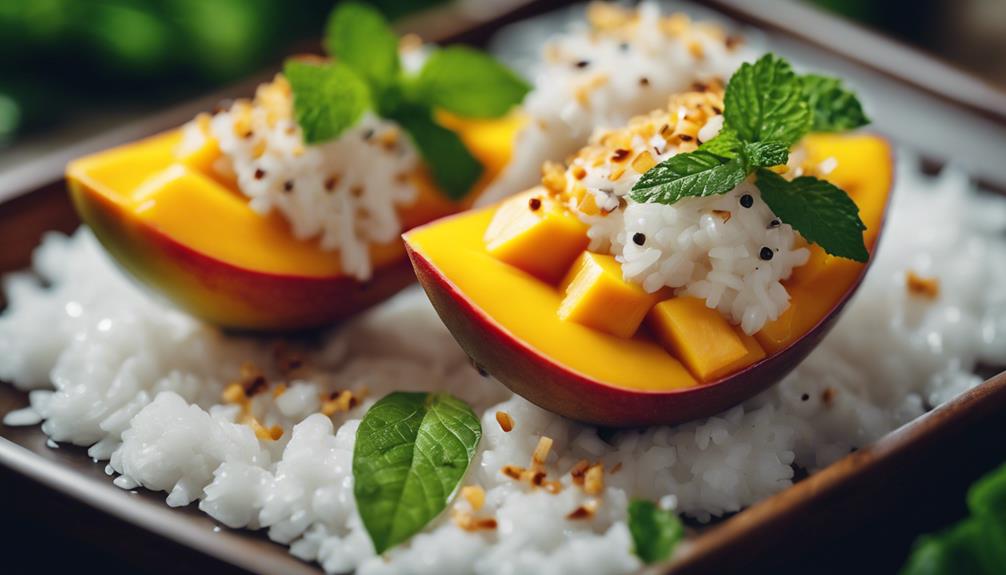
Check out the featured Mango Sticky Rice recipe, a top-rated favorite among mango dessert enthusiasts.
This dish combines the sweetness of ripe mangoes with the creamy texture of coconut-infused sticky rice, creating a delectable treat for your taste buds.
Get ready to experience a burst of tropical flavors in every bite with this mouthwatering dessert!
Featured Mango Sticky Rice Recipe
For a taste of culinary delight, explore this top-rated Mango Sticky Rice recipe.
- Ripe Mango Variations: Choose from a variety of mango types such as Ataulfo, Tommy Atkins, or Champagne for different sweetness levels and textures.
- Coconut Milk Infusion: Simmer sticky rice in rich coconut milk to infuse it with a creamy, tropical flavor.
- Palm Sugar Caramelization: Drizzle warm palm sugar syrup over the rice for a delightful sweet and savory contrast.
- Toasted Sesame Seeds: Sprinkle toasted sesame seeds on top for a nutty crunch that complements the soft rice and juicy mango.
- Fresh Mint Garnish: Finish off your dish with a few fresh mint leaves to add a pop of color and a revitalizing herbal note to the dessert.
Prepare this Mango Sticky Rice with its unique blend of mango variations, sweet and savory flavors, and delightful toppings for a dessert that will impress and satisfy your guests with its exotic taste profile.
Sticky Rice Soaking Technique
When preparing sticky rice, soaking is essential for achieving the right texture. Start by selecting water at room temperature to cover the rice fully.
Let the rice soak for at least 4 hours or ideally overnight for the best results.
Rice Soaking Importance
Soaking sticky rice before cooking is necessary for achieving the desired texture and consistency in your mango sticky rice dish. This process helps the rice grains absorb water gradually, leading to a chewy and slightly sticky texture that's characteristic of this traditional Asian dessert. Additionally, soaking allows for flavor infusion, as the rice grains open up and become more receptive to the coconut milk and sugar mixture that gives mango sticky rice its delicious taste.
To soak sticky rice properly, rinse the rice thoroughly to remove excess starch. Then, cover the rice with water and let it sit for at least 4 hours or overnight. This step is vital for ensuring that the rice cooks evenly and becomes tender without turning mushy.
Water Temperature Selection
To guarantee the best texture and flavor development of your sticky rice, consider the water temperature carefully when soaking the grains. When preparing sticky rice for your sous vide mango sticky rice dessert, opt for room temperature water. This temperature choice helps the rice grains absorb water evenly, leading to a consistent texture in the final dish. Avoid using hot water as it can start cooking the rice prematurely, affecting the sous vide precision cooking process.
Sous vide cooking relies on precise temperatures to achieve perfect results. By using room temperature water, you create an ideal environment for the rice to slowly hydrate without any risk of overheating. This gentle approach ensures that the sticky rice retains its unique chewy texture, essential for a traditional mango sticky rice experience.
Soaking Duration Tips
Consider the best duration for soaking your sticky rice to guarantee it achieves the desired consistency for your sous vide mango sticky rice dessert. When preparing sticky rice for sous vide cooking, the soaking duration plays a pivotal role in ensuring the rice's texture and flavor infusion.
Ideally, soaking the sticky rice for around 4 to 6 hours or overnight in water allows it to absorb moisture evenly, resulting in a soft and chewy texture once cooked sous vide. This soaking process also aids in enhancing the flavor infusion of the rice, allowing it to better absorb the sweet coconut milk and fresh mango flavors in the final dish.
To achieve the perfect balance of tenderness and flavor in your mango sticky rice, experiment with different soaking durations to find what works best for your preferences. Remember, the longer the soaking time, the more moisture the rice absorbs, leading to a creamier consistency.
Final Thoughts
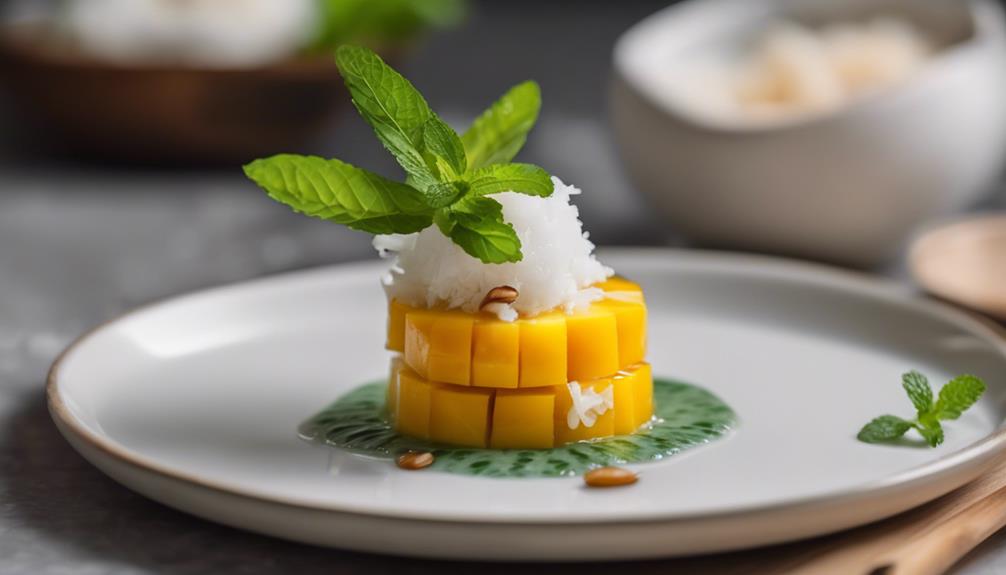
As you conclude your sous vide mango sticky rice culinary journey, remember to savor each bite of this delightful dessert that encapsulates the perfect balance of flavors.
When serving this dish, consider the importance of dessert presentation; a beautifully arranged plate can enhance the dining experience, showing your cultural appreciation for the origins of this traditional Asian treat.
Additionally, don't be afraid to experiment with flavor variations and modern twists to put your unique spin on this classic recipe. Whether you choose to infuse the sticky rice with different extracts or top it with unconventional garnishes, the possibilities for creativity are endless.
By exploring these new avenues, you not only honor the dessert's heritage but also contribute to its evolution in the culinary world.
Embrace the joy of cooking and sharing this beloved dessert with others, spreading the love and connection that food can bring.
Frequently Asked Questions
Can I Use Regular Rice Instead of Sticky Rice for This Dessert?
Yes, you can use regular rice as an alternative for this dessert. However, keep in mind that the texture and taste may differ slightly. Experiment with it to create a unique twist on the traditional dish.
How Can I Store Leftover Sous Vide Mango Sticky Rice?
To store leftover sous vide mango sticky rice, freeze in airtight containers for long term storage. When ready to enjoy, reheat gently using a microwave or stovetop with a sprinkle of water to maintain the flavors and textures.
Can I Substitute Coconut Milk With Another Type of Milk?
Yes, you can substitute coconut milk with dairy alternatives like almond or soy milk. This small recipe modification can bring about new flavor variations to your dish. Experiment with different cooking techniques to enhance the taste!
Is There a Vegan-Friendly Version of Mango Sticky Rice?
For a vegan-friendly version of mango sticky rice, consider using coconut milk alternatives like almond or oat milk. These substitutions not only cater to dietary needs but also offer health benefits such as lower saturated fat content.
Can I Use Frozen Mangoes Instead of Fresh Ones for This Recipe?
Yes, you can use frozen mangoes as a substitute in the recipe. Cooking time may vary slightly, but the flavor impact will still be delicious. Expect a slight texture difference, but overall, it's a great alternative.
Conclusion
To sum up, sous vide mango sticky rice is a delicious and traditional Asian dessert that combines the sweetness of mango with the creaminess of coconut milk and the stickiness of rice.
By following the proper soaking technique and using the sous vide method, you can create a top-rated version of this classic dish right in your own kitchen.
Enjoy this flavorful treat as a delightful end to any meal, and impress your friends and family with your culinary skills.
